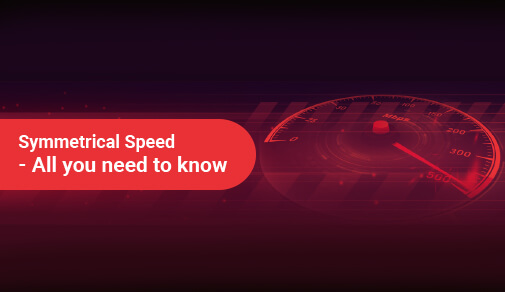Symmetrical Speed - All you need to know
- 245
- |
- 31 March 2021
- |
- 3 minutes

It's likely you're unaware, but when an internet plan advertises its speed, it almost always just mentions the download speed. The upload speed can be somewhat different from the download speed, and an asymmetrical plan is one in which the upload speed is lower than the download speed. A symmetrical plan is one in which the upload and download rates are the same.
What is Symmetrical Speed?
Symmetrical links are just as they sound like: they have the same download and upload rates. For example, a 500/500 Mbps fibre internet link offers download and upload speeds of 500 Mbps. An asymmetrical connection, on the other hand, does not have the same download/upload rates as a symmetrical connection. 60/3, for example, denotes a download speed of 60 Mbps and an upload speed of 3 Mbps.
Pros of a Symmetrical Connection
- There are no internet bottlenecks. If you're experiencing slow uploads and dropped calls, it's likely that your data is being "clogged" as a result of a shortage of usable bandwidth during peak traffic times. You and your employees can experience a significant drop in productivity as a result of this. Due to high use, symmetrical connections ensure that your upload speeds are not strained.
- Uploads of larger (and faster) files. We've all been there. Uploading files to the cloud takes a long time, so you put it off as long as you can. With symmetrical speeds, you can upload and update at the same time, enabling you to cross backing up your projects off your to-do list.
- Cloud services that are readily available. More and more enterprises are migrating to the cloud because of the improved versatility it provides – but what good is a cloud you can't access? High upload speeds are needed for secure cloud access, so symmetrical connections can ensure that your cloud services are always available.
##BlogVASBanner##
What is Asymmetrical Speed?
If you test your Internet speed at home, you'll find that your upload speeds are usually a fraction of your download speeds. An asymmetrical relation is what this is called. In an office setting where bandwidth is versatile, an asymmetrical connection is typically the best choice. FTTC and FTTP circuits are examples of asymmetrical connections. You can get fast download speeds with these types of connections, with upload speeds being about 10% of the download speeds. Asymmetrical networks often have the drawback of being congested, which means that your Internet speed is directly proportional to the amount of traffic in your city.
Pros of an Asymmetrical Connection
- The cost: Connections that are asymmetrical are almost always less expensive.
- Download speeds are fast: With an asymmetrical link, you'll get high-speed downloading even though uploading takes a long time. If uploading isn't a top priority for your company, you may not need to spend the extra money.
Why do you need symmetrical internet speeds?
Most of us have managed to get by with upload speeds of less than 50 Mbps. Is symmetrical internet even worth it if we've managed to get by without fast upload speeds so far? You probably don't need symmetrical internet if you're just browsing Facebook, forwarding emails to your nieces and nephews, or searching Google for the latest sports scores. We think symmetrical internet is a huge plus if you’re one of these types of people:
- Students
- Businesses
- Telecommuters
- Content creators
- Gamers



